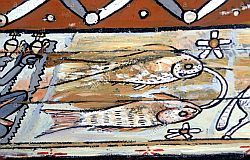
|
|
EgyptStar Lore
|
|



|
|
Aquarius
In ancient Babylon Aquarius was associated with the destructive floods that the
Babylonians regularly experienced; a concept that was adopted in ancient Egypt as well.
|

|



|
|
Aquila
Egyptian constellations are still highly disputed and open to interpretation.
|
 Falcon-headed Horus, 1290 BC
Falcon-headed Horus, 1290 BCTemple of Seti I Source: Wikipedia
|



|
|
Argo Navis
Greek philosopher Plutarch attributed the constellation to the Egyptian
Barque of Osiris.
|

|



|
|
Cancer
R.H. Allen reports Egyptian
records of about 2000 B.C. in which the constellation Cancer was was described as a sacred Scarabaeus, an emblem of immortality.
|

|



|
|
Canis Major
Sirius, the brightest star in the night sky was the basis
for the ancient Egyptian calendar, as the
heliacal rising of Sirius marked the flooding of the Nile.
Source: Wikipedia, Wikipedia, Ridpath & Tirion: Stars and Planets Guide |
 Sopdet, Gregorian Egyptian Museum
Sopdet, Gregorian Egyptian MuseumSource: Wikipedia |



|
|
Canis Minor According to Mark R. Chartrand, the ancient Egyptians thought of this constellation as Anubis, the jackal god. Source: Wikipedia |
 Anubis Statue, Vatican Museums
Anubis Statue, Vatican MuseumsSource: Wikipedia |



|
|
Libra
Egyptian constellations are still very controversially discussed. Gyula Priskin
suggests that in the decanal procession of strip B on the astronomical ceiling of Esna, the brightest stars of Libra,
α, β and
γ Librae were seen as a boat.
|
 Libra in the
Libra in theastronomical ceiling of Esna Source: Gyula Priskin |



|
|
Milky Way
In Egyptian mythology, the Milky Way was seen as a pool of cow's milk related to
the fertility cow-goddess Bat.
|

|

|



|
|
Orion
In Egyptian astronomy, the stars of Orion and Lepus, together with some neighboring
stars formed the constellation Sah.
Sources: Wikipedia and Astronomytrek |

|


|
Orion
The Metternich Stela is dated to the
Thirtieth dynasty of Egypt, around 380–342 BC. The stela tells the
story of the death and resurrection of Horus.
Sources: Sacred Texts and
Chandra Observatory |
 Metternich Stela; Source: Wikipedia
Metternich Stela; Source: Wikipedia
|



|
|
Pisces
The ancient Egyptian knew of Pisces, seeing in it a creation story and the "fish of the Nile." The symbol of Pisces’ two fish has been found on the
lid to an Egyptian sarcophagus dating back to 2300 BCE.
|
 Egyptian sarcophagus (from Aegyptische Urkunden; koenigliche Museen zu Berlin)
Egyptian sarcophagus (from Aegyptische Urkunden; koenigliche Museen zu Berlin)© alamy.com |



|
|
Scorpius
The brightest star in the constellation Scorpius is Antares.
|
 Scorpion goddess Serket in The Louvre
Scorpion goddess Serket in The Louvre© Francesco Dazzi |



|
|
Taurus
Quoting Wikipedia: To the Egyptians, the constellation Taurus was a sacred bull that was associated with the renewal of life in spring. When the
spring equinox entered Taurus, the constellation would become covered by the Sun in the western sky as spring began. This "sacrifice" led to the
renewal of the land.
|



|
|
Ursa Major
The ancient Egyptians had two words for the asterism we call the Big Dipper, both related to farm or draught animals:
|

|


|
Back to Star Lore |
Back to Mythology |
Back to Space Page |
Back to English |
 Back to Start Page |